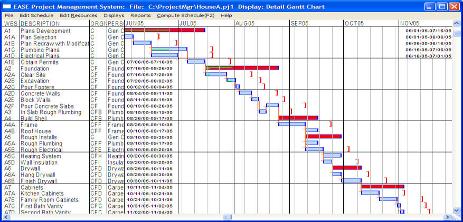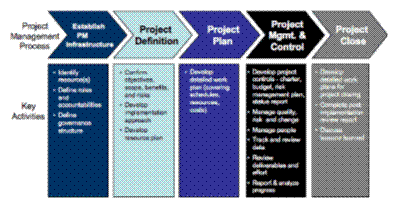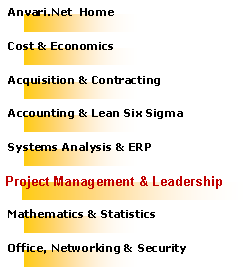


|
The course materials listed on this web site are copy rights � by the subject authors and publishers. They are solely intended for classroom teaching and online reference. Copy and/or redistribution of these contents are prohibited by the US copyright law. |

|
Project management is the way a person organizes and manages resources that are necessary to complete a project. People that manage projects are known as Project Managers. A project is a piece of work which is not a process or an operation. It has a start, an end, and goals. Projects can be very simple, like organizing a party, or very complex, like building a space rocket. Projects are common in the construction industry, the telecommunications industry and the IT industry. The management of a project requires special skills. Project managers must ensure that the project is delivered within the existing limitations. These limitations can be time, cost, people, risk, and many more. Project managers must also ensure the best possible distribution of resources. A project manager works mainly with people. They need to have people management skills, a good understanding of the tasks and skills needed on a project, an understanding of how long tasks will take, good organizing skills, good communication skills, and good efficiency skills. Project managers do not need to know how to do all of the work that may be needed in a project. For instance, a building project manager does not need to know how to pour concrete. However, they need to know how to manage people that pour concrete, and they need to know how long concrete takes to pour, how much it costs, what needs to happen before concrete is poured, and what needs to happen after concrete is poured.
Operations management is an area of management concerned with overseeing, designing, and controlling the process of production and redesigning business operations in the production of goods or services. It involves the responsibility of ensuring that business operations are efficient in terms of using as few resources as needed, and effective in terms of meeting customer requirements. It is concerned with managing the process that converts inputs (in the forms of raw materials, labor, and energy) into outputs (in the form of goods and/or services).[1] The relationship of operations management to senior management in commercial contexts can be compared to the relationship of line officers to highest-level senior officers in military science. The highest-level officers shape the strategy and revise it over time, while the line officers make tactical decisions in support of carrying out the strategy. In business as in military affairs, the boundaries between levels are not always distinct; tactical information dynamically informs strategy, and individual people often move between roles over time. According to the United States Department of Education, operations management is the field concerned with managing and directing the physical and/or technical functions of a firm or organization, particularly those relating to development, production, and manufacturing. Operations management programs typically include instruction in principles of general management, manufacturing and production systems, factory management, equipment maintenance management, production control, industrial labor relations and skilled trades supervision, strategic manufacturing policy, systems analysis, productivity analysis and cost control, and materials planning.[2][3] Management, including operations management, is like engineering in that it blends art with applied science. People skills, creativity, rational analysis, and knowledge of technology are all required for success.
Operations management. Although productivity benefited considerably from technological inventions and division of labour, the problem of systematic measurement of performances and the calculation of these by the use of formulas remained somewhat unexplored until Frederick Winslow Taylor. Frederick Taylor early work focused on developing what he called a "differential piece-rate system"[8] and a series of experiments, measurements and formulas dealing with cutting metals[9] and manual labor.[10] The differential piece-rate system consisted in offering two different pay rates for doing a job: a higher rate for workers with high productivity (efficiency) and who produced high quality goods (effectiveness) and a lower rate for those who fail to achieve the standard. One of the problems Taylor believed could be solved with this system, was the problem of soldiering: faster workers reducing their production rate to that of the slowest worker. In 1911 Taylor published his "The Principles of Scientific Management",[11] in which he characterized scientific management (also know as Taylorism) as: The development of a true science; The scientific selection of the worker; 1. The scientific education and development of the worker; Intimate friendly cooperation between the management and the workers. 1 Taylor is also credited for developing stopwatch time study, this combined with Frank and Lillian Gilbreth motion study gave way to time and motion study which is centered on the concepts of standard method and standard time. Frank Gilbreth is also responsible for introducing the flow process chart. Other contemporaries of Taylor worth remembering are Morris Cooke (rural electrification in the 1920s and implementer of Taylor's principles of scientific management in the Philadelphia's Department of Public Works), Carl Barth (speed-and-feed-calculating slide rules ) and Henry Gantt (Gantt chart). Also in 1910 Hugo Diemer published the first industrial engineering book: Factory Organization and Administration. 2 In 1913 Ford W. Harris published his "How Many parts to make at once" in which he presented the idea of the economic order quantity model. He described the problem as follows: 3 "Interest on capital tied up in wages, material and overhead sets a maximum limit to the quantity of parts which can be profitably manufactured at one time; "set-up" costs on the job fix the minimum. Experience has shown one manager a way to determine the economical size of lots"[12] 4 This paper inspired a large body of mathematical literature focusing on the problem of production planning and inventory control. 5 In 1924 Walter Shewhart introduced the control chart through a technical memorandum while working at Bell Labs, central to his method was the distinction between common cause and special cause of variation. In 1931 Shewhart published his Economic Control of Quality of Manufactured Product,[13] the first systematic treatment [14] of the subject of Statistical Process Control (SPC). 6 In the 1940s methods-time measurement (MTM) was developed by H.B. Maynard, JL Schwab and GJ Stegemerten. MTM was the first of a series of predetermined motion time systems, predetermined in the sense that estimates of time are not determined in loco but are derived from an industry standard. This was explained by its originators in a book they published in 1948 called "Method-Time Measurement".[15] 7 Up to this point in history, optimization techniques were known for a very long time, from the simple methods employed by F.W.Harris to the more elaborate techniques of the calculus of variations developed by Euler in 1733 or the multipliers employed by Lagrange in 1811, and computers were slowly being developed, first as analog computers by Sir William Thomson (1872) and James Thomson (1876) moving to the electromechanically computers of Konrad Zuse (1939 and 1941). During World War II however, the development of mathematical optimization went trough a major boost with the development of the Colossus computer, the first electronic digital computer that was all programmable, and the possibility to computationally solve large linear programming problems, first by Kantorovich in 1939 working for the Soviet government and latter on in 1947 with the simplex method of Dantzig. These methods are known today as belonging to the field of operations research. 8 From this point on a curious development took place: while in the United States the possibility of applying the computer to business operations led to the development of management software architecture such as MRP and successive modifications, and ever more sophisticated optimization techniques and manufacturing simulation software, in post-war Japan a series of events at Toyota Motor led to the development of the Toyota Production System (TPS) and Lean Manufacturing. 9 In 1943, in Japan, Taiichi Ohno arrived at Toyota Motor company. Toyota evolved a unique manufacturing system centered on two complementary notions: just in time (produce only what is needed) and autonomation (automation with a human touch). Regarding JIT, Ohno was inspired by American supermarkets[16]: workstations functioned like a supermarket shelf where the customer can get products they need, at the time they need and in the amount needed, the workstation (shelf) is then restocked. Automation was developed by Toyoda Sakichi in Toyoda Spinning and Weaving: an automatically activated loom that was also foolproof, that is automatically detected problems. In 1983 J.N Edwards published his "MRP and Kanban-American style" in which he described JIT goals in terms of seven zeros:[17] zero defects, zero (excess) lot size, zero setups, zero breakdowns, zero handling, zero lead time and zero surging. This period also marks the spread of Total Quality Management (TQM) in Japan, ideas initially developed by American authors such as Deming, Juran and Armand V. Feigenbaum.[18] TQM is a strategy for implementing and managing quality improvement on an organizational basis, this includes: participation, work culture, customer focus, supplier quality improvement and integration of the quality system with business goals.[14] Schnonberger[19] identified seven fundamentals principles essential to the Japanese approach: 1) Process control: SPC and worker responsibility over quality 2) Easy able -to-see quality: boards, gauges, meters, etc. and poka-yoke 3) Insistence on compliance: "quality first" 4) Line stop: stop the line to correct quality problems 5) Correcting one's own errors: worker fixed a defective part if he produced it 6) The 100% check: automated inspection techniques and foolproof machines 7) Continual improvement: ideally zero defects
Recent trends in the field revolve around concepts such as: Business Process Re-engineering (launched by Michael Hammer in 1993[22]): a business management strategy focusing on the analysis and design of workflows and business processes within an organization. BPR seeks to help companies radically restructure their organizations by focusing on the ground-up design of their business processes. Lean Manufacturing: a systemic method for the elimination of waste ("Muda") within a manufacturing process. Lean also takes into account waste created through overburden ("Muri") and waste created through unevenness in work loads ("Mura"). The term lean manufacturing was coined in the book The Machine that Changed the World. [23] Six Sigma (an approach to quality developed at Motorola between 1985-1987): Six Sigma refers to control limits placed at six (6) standard deviations from the mean of a normal distribution, this became very famous after Jack Welch of General Electric launched a company-wide initiative in 1995 to adopt this set of methods. More recently, Six Sigma has included DMAIC (for improving processes) and DFSS (for designing new products and new processes) Reconfigurable Manufacturing Systems: a production system designed at the outset for rapid change in its structure, as well as its hardware and software components, in order to quickly adjust its production capacity and functionality within a part family in response to sudden market changes or intrinsic system change. _________________________
Introduction to Positive Psychology * A word is a thought revealed ___________________________
Campbell Leadership Index An assessment of leadership characteristics The Center for Creative Leadership Fundamental Interpersonal Relations Orientation�Behavior (FIRO-B) Interpretive Report for Organizations Myers-Briggs Type Indicator The MBTI Personality Assessment The Office of Personnel Management (OPM) The University of Michigan- Ross School of Business The Center for Creative Leadership Situation-Behavior-Impact (SBI) Observation and Conversation ___________________ |
